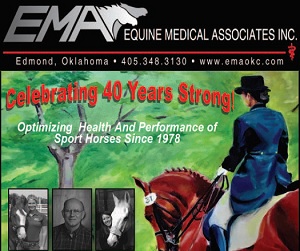Early detection for better outcomes
Written By Grace Owen, DVM
Equine Medical Associates
Edmond, OK
Neurologic diseases in horses affect the central nervous system (CNS). They can sometimes be difficult to diagnose as many of them carry similar clinical signs. Some of these symptoms can be especially scary for horse owners as they involve varying degrees of ataxia (lack of voluntary muscle movements leading to incoordination). Understanding some of the more common neurologic diseases may help owners detect symptoms early, leading to a better outcome.
Equine Viral Encephalomyelitis
Eastern, Western and Venezuela equine encephalitis (EEE, WEE and VEE respectively) are all types of arboviruses. These arboviruses are transmitted by a blood-feeding insect, such as a fly or mosquito. In horses, these viruses can cause fatal neurologic disease.
Once bitten by a mosquito, it can take two days to three weeks for a horse to develop clinical signs. These signs can include high fever, lack of appetite, depression and loss of ability to swallow. Behavioral changes such as aggression or hyper-reactivity, incoordination, circling and even inability to remain standing may also be seen. Fatality for horses with EEE is the highest at 75-95%, with WEE being about 20-40%. EEE primarily occurs in the eastern parts of the U.S. WEE is seen mostly west of the Mississippi. VEE is mostly seen in South and Central America.
Diagnosis for these diseases comes from serum antibody titer levels, using an ELISA (enzyme-linked immunosorbent assay), or less commonly a PCR (polymerase chain reaction) from CSF tap (cerebrospinal fluid). These tests can be completed by your veterinarian. There is no cure for equine encephalitis. Treatment is aimed at supportive care in symptomatic horses.
Equine encephalitis is a preventable disease with vaccination. In the U.S., we vaccinate for EEE and WEE with an initial first vaccination, followed in four to six weeks with a booster. Annual vaccination is recommended afterward. If you are in an area where mosquitos are present year-round, bi-annual vaccination is recommended. Controlling insect populations and using fly spray can also reduce the risk to your horse.
Equine Herpesvirus (EHV-1 Myeloencephalopathy)
Equine herpesviruses are commonly found in horses all over the world. Almost all horses have been infected with the virus at some point with no serious side effects. So far, we have identified nine different types of EHV, but the one that can cause neurologic disease is related to EHV-1, which can cause respiratory disease, abortion and the neurological form of the disease. EHV-1 myeloencephalopathy (EHM) results from inflammation of the blood vessels causing the death of neurologic tissue.
EHV is contagious from horse to horse and is spread from nasal secretions. It can also be spread from contact with objects like shared feeders, water troughs or grooming equipment. The virus can live in the environment seven days, but in some cases, it can live up to a month. Typically, signs develop four to six days after exposure. Symptoms include nasal discharge, lethargy, fever, incoordination, lack of tail tone, lack of appetite, head tilt, urine dribbling and inability to stand. The neurologic form can be fatal. Diagnosis can be performed by nasal swab for PCR. Treatment is non-specific supportive care, which may include fluid therapy and NSAIDs (non-steroidal anti-inflammatories) to control fever. Vaccinations are available to prevent the abortive and respiratory forms of EHV-1, but we currently don’t have a vaccine labeled for the neurologic form. Prevention lays in good biosecurity.
West Nile Virus (WNV)
Horses contract West Nile virus from a mosquito that has previously fed on an infected bird. Birds build up a large amount of the virus in their blood and serve as the only source of the virus for mosquitos. Horses are a dead-end host, which means they do not transmit the virus to other horses.
There have been more than 25,000 WNV cases in horses since 1999. About 33% of cases in horses are fatal. Horses that are able to survive the disease often have some longer lasting neurologic signs. Clinical signs of the disease include ataxia, stumbling, fever, muscle fasciculations (twitching), hyperexcitability, lip droop, inability to swallow and recumbency. West Nile virus can be identified by PCR testing from a blood sample. There is no specific treatment, but supportive care is recommended. Prevention is achieved by vaccination and mosquito control.
Rabies
Rabies is a virus that is transmitted from the bites of infected animals through their saliva. In Oklahoma, the most common host of rabies is the skunk, but it can affect dogs, cats, bats, raccoons, foxes and livestock. After being bitten by an infected animal, it takes two to six weeks for symptoms to develop. The symptoms can start out subtly. These include sudden changes in behavior that can range from depression to manic, head pressing and circling, muscle tremors, loss of appetite, inability to swallow and, sometimes, sudden death.
There is no treatment for rabies, and death follows clinical signs very quickly. Unfortunately, diagnosis of rabies is only able to be performed postmortem with samples of brain tissue. The good news is that rabies is preventable with vaccination. It is important to note that rabies is a zoonotic disease, meaning it can affect humans as well; therefore, vaccination is strongly recommended.
Equine Protozoal Myeloencephalitis (EPM)
EPM can be a challenging disease to diagnose. For starters, approximately 50% of horses in the U.S. may have been exposed to the causative organism called Sarcocystis neurona. The protozoa are spread by the possum, which is the definitive host, through fecal material. When the horse contacts the infective sporocysts by ingestion, the sporocysts migrate to the intestinal tract and then into the bloodstream. They then cross the blood/brain barrier. At this point, the sporocysts attack the central nervous system and when left untreated can cause devastating and potentially lasting neurological damage.
Symptoms of EPM can include muscle atrophy, behavioral changes, head tilt, inability to swallow, ataxia, sweating in abnormal patterns, abnormal gait and/or lameness. There are several factors that may influence degree of disease. The amount of the organism that is present, how long it is present before treatment, as well as the point in the spinal cord that the organism is present can affect the severity of the disease. It is also thought that stressful events, by straining the immune system, may increase the severity of the disease or even bring on clinical signs in an asymptomatic horse.
Diagnosis is difficult as there is no proven assay for this disease, and clinical symptoms are often like other neurologic diseases. Blood tests can confirm exposure to the organism and coupled with clinical symptoms are often considered diagnostic. Cerebrospinal fluid can be obtained for more accurate diagnosis, but the sample collection has some risks.
There are multiple treatment protocols available, including several that are FDA approved. Most treatments last about 30 days and have minimal side effects noted. These treatments can be expensive. Discuss options with your veterinarian based on your horse’s specific case.
Neurologic diseases in horses can be scary for horse owners and challenging for veterinarians. Early identification of disease is important for successful treatment. In most cases, the diseases can be prevented by vaccination and insect control. Talk to your veterinarian about vaccination protocols in your area.

